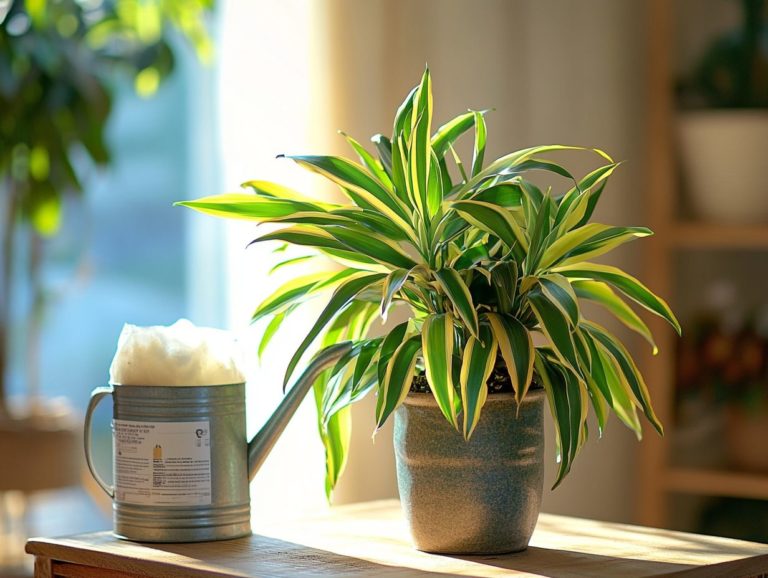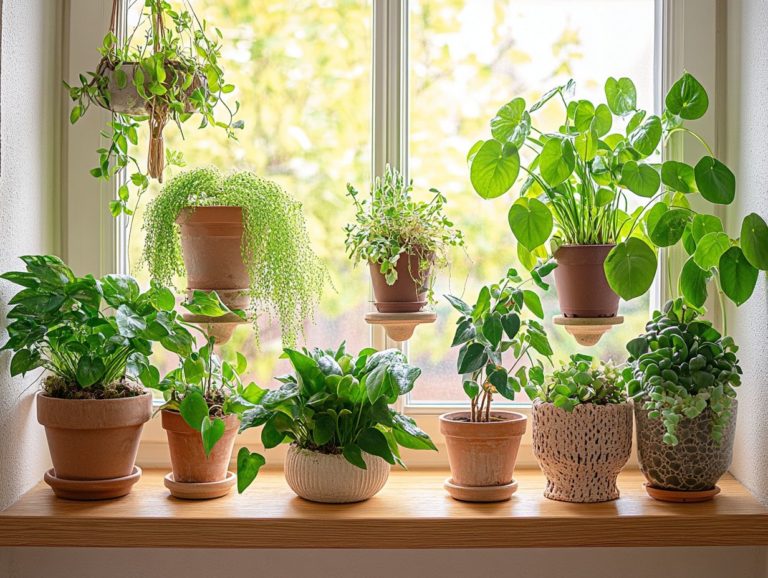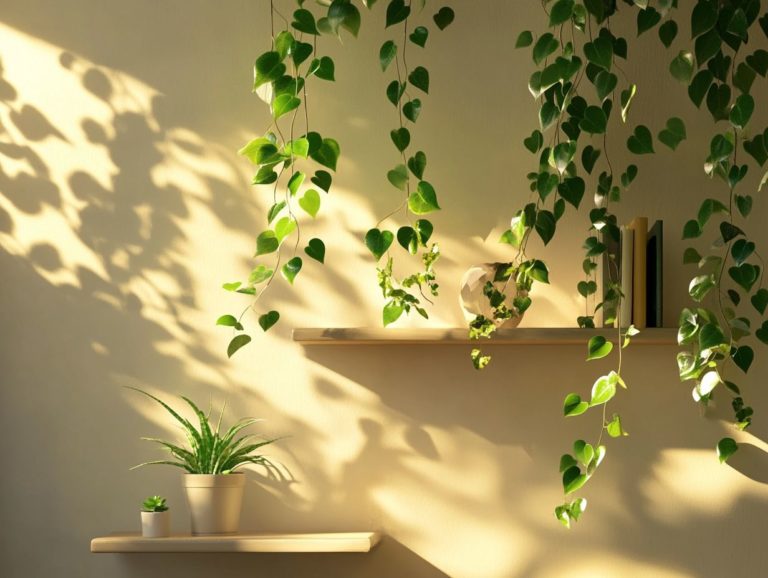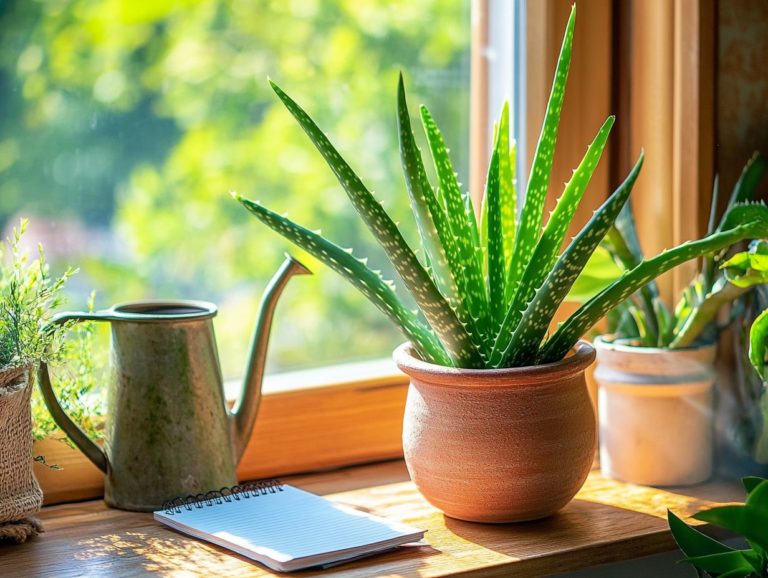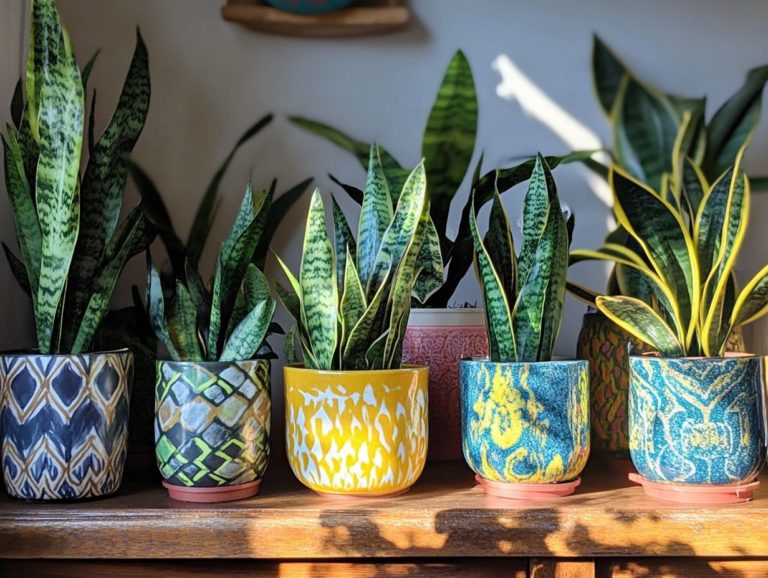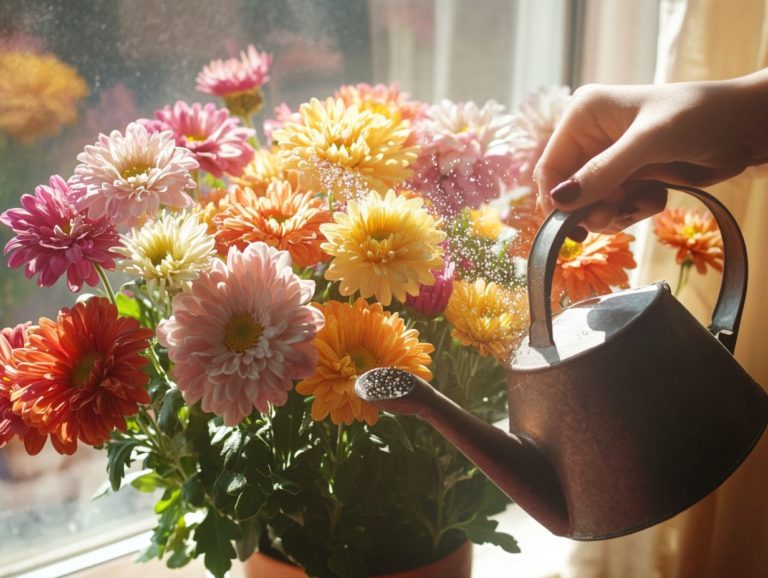Understanding the Care of Indoor Hibiscus
Hibiscus plants brighten your indoor spaces with vibrant colors and tropical charm. They also help clean the air and boost humidity, making your home healthier.
This guide covers the essentials of hibiscus care, starting with selecting the right varieties and creating ideal light and temperature conditions for thriving houseplants.
You ll learn best practices for watering and fertilizing, effective pruning techniques, and tips for identifying and treating common pests and diseases like powdery mildew.
Discover when and how to transfer your hibiscus to a larger pot to ensure continued growth. Learn the secrets to keeping your indoor hibiscus healthy and flourishing, especially during semi-dormancy.
Contents
Key Takeaways:

- Proper lighting and temperature are crucial for the health of indoor hibiscus plants. Aim for bright, indirect light and keep temperatures between 60-80 F for optimal growing conditions. Ensure adequate humidity levels to enhance growth.
- Regular pruning and maintenance are essential for keeping your indoor hibiscus healthy. This includes methods like pinch pruning, removing dead branches, and checking for common pests.
- Understanding proper watering and feeding techniques is key to caring for indoor hibiscus. These heavy feeders need consistent moisture and regular fertilization with organic options. Transfer them to larger pots when necessary for healthy growth.
Hibiscus Plant Basics
Hibiscus plants dazzle with their exquisite blooms and tropical charm, making them a favorite among indoor gardening enthusiasts.
These tropical beauties come in various species, like Hibiscus rosa-sinensis, known for its vibrant flowers, and Hibiscus syriacus, which adds elegance to any setting.
If you’re interested in cultivated varieties, organizations like the American Hibiscus Society and the International Hibiscus Society provide valuable resources to help you choose the perfect hibiscus to enhance your collection, including varieties like Belle du Jour and Blue Ballerina.
Overview and Types of Indoor Hibiscus
Indoor hibiscus varieties include both the beloved common species and stunning hybrids with vibrant colors and unique shapes.
Each type offers a distinct experience for plant lovers, with various growth habits suited to different spaces and tastes. Common varieties typically grow upright, while hybrids may spread out with larger, extravagant blooms, perfect for enhancing your indoor environment.
Understanding their specific care needs, such as light and humidity, is vital. Some thrive in bright, indirect light, while others prefer a bit of shade. For those interested in indoor plants, understanding the care of indoor palms can enhance your gardening experience. Gardening enthusiasts enjoy both reliable common types and the stunning allure of specialty hybrids, making indoor hibiscus an exquisite choice for decor and relaxation.
Light and Temperature Requirements
Knowing the light and temperature needs of your hibiscus plants is key to unlocking their stunning growth and blooming potential. These tropical plants thrive in well-lit spaces that mimic their natural habitats, ideally enjoying plenty of indirect sunlight, making them perfect for bright indoor settings.
Maintaining the right humidity levels is also critical for these heavy feeders, supporting their optimal growth and helping them flourish.
Optimal Growing Conditions
To cultivate optimal growing conditions for your hibiscus, you must prioritize the right balance of sunlight, humidity, and temperature. This ensures these tropical beauties thrive in your home and enhance the indoor atmosphere.
These plants flourish when they bask in full sun for at least six hours each day, allowing their vibrant flowers to truly shine. Maintaining a temperature between 60 F and 90 F is crucial; extremes can stifle their growth and blooming potential. Aim for humidity levels around 50-60% to mimic their native tropical habitat and help the leaves grow thick and healthy.
Regularly mist the leaves to maintain the right humidity levels, or position the pot on a tray filled with water and pebbles. This creates a balanced microclimate that keeps your hibiscus happy and bursting with color while also increasing oxygen levels.
Watering and Fertilizing
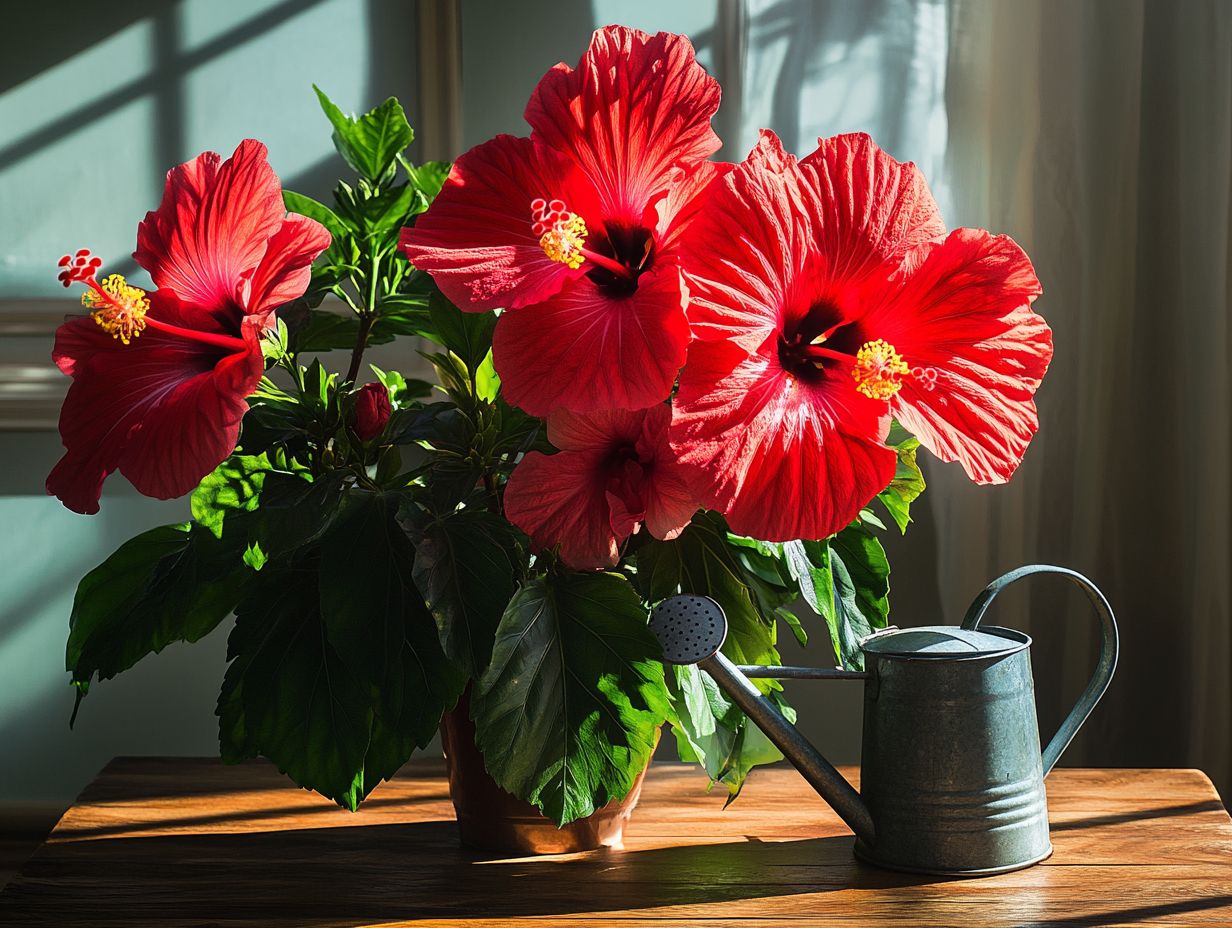
Watering and fertilizing hibiscus correctly is essential. These plants that need a lot of nutrients thrive on consistent moisture and ample nutrients, including nitrogen and potassium.
With the right care, your hibiscus will flourish beautifully indoors.
Best Practices for Watering and Feeding
Understanding the best practices for watering and feeding hibiscus is essential to meet their unique needs. Use organic fertilizers rich in nitrogen, potassium, magnesium, and iron to significantly promote healthy growth.
Ensure that the soil maintains a slightly acidic pH to support optimal nutrient absorption. Water thoroughly, allowing it to penetrate deep into the root zone. Be cautious to prevent waterlogging, as hibiscus thrives best with good drainage. This is particularly important for managing common hibiscus pests.
Regularly inspect the leaves of your plants for signs of nutrient deficiencies, such as yellowing or browning. These signals indicate a need to adjust your feeding practices. By keeping a close eye on these factors, you can foster vibrant blooms and lush foliage throughout the growing season.
Pruning and Maintenance
Pruning and maintaining your hibiscus plants is essential for promoting robust growth and ensuring they thrive. This ultimately leads to an abundance of stunning flower buds and a vibrant display.
Regularly pinch back new growth to encourage branching, which enhances the plant’s overall shape. This practice contributes to the beauty of your hibiscus and reinforces its health, creating a vibrant display that can even act as a sound barrier.
How to Keep Your Hibiscus Healthy
To keep your hibiscus thriving, establish a consistent care routine that emphasizes key elements like watering, sunlight exposure, and regular pruning. This approach fosters robust growth and encourages those vibrant blooms you desire, while also enhancing creativity and productivity.
Monitor the soil’s moisture levels to ensure it doesn’t swing too far into the territory of being overly dry or waterlogged. Both extremes can jeopardize your plant’s health and lead to potential growth issues.
Position your hibiscus in a spot that bathes in at least six hours of direct sunlight each day. This will enhance its blooming potential and prevent pesky leggy growth, contributing to better overall health.
Don t wait remove spent flowers and leaves immediately to keep your plant healthy. This simple act tidies up your plant and minimizes the risk of pests and diseases associated with poor indoor conditions.
If you encounter challenges like yellowing leaves or stunted growth, reassess your fertilization schedule and address any nutrient deficiencies, focusing particularly on nitrogen and magnesium. Additionally, understanding the care of indoor zinnias could make a world of difference in restoring your hibiscus’s vitality.
Common Pests and Diseases
Common insect pests and diseases pose a significant threat to the health of your hibiscus plants. It is crucial to identify and address these problems swiftly. By doing so, you ll ensure vigorous growth and stunning blooms throughout the season, keeping your houseplants vibrant and healthy.
Identifying and Treating Issues

Identifying and addressing issues is essential for hibiscus health!
Common problems include spider mites and yellowing leaves, which often indicate nutrient deficiencies requiring fish emulsion or organic fertilizers.
Watch for signs of pests, like tiny webs or speckled leaves. Catching these early prevents further damage!
Diseases such as powdery mildew show up as a white film. Improve air circulation and consider applying fungicide to keep your plants healthy.
Implementing proper watering practices and making necessary soil amendments can effectively resolve nutrient deficiencies, helping your hibiscus thrive. Understanding how to boost growth will help your hibiscus bloom vibrantly.
Repotting and Transplanting
Repotting and transplanting hibiscus plants is crucial for their growth, especially when they ve outgrown their current containers or need fresh, nutrient-rich soil to flourish. This ensures optimal conditions for these tropical plants.
Ensure the soil is slightly acidic for optimal growth!
When and How to Repot Your Hibiscus
Knowing when and how to repot your hibiscus is essential. These vibrant plants typically thrive when repotted every two years or when their roots start feeling a bit cramped.
Keep an eye out for subtle signs that signal it s time for a change. If you notice roots poking out of the drainage holes or a sudden drop in growth, repotting may be necessary!
To ensure successful repotting, choose a pot that is one size larger and features good drainage to prevent waterlogging.
- Carefully remove the hibiscus from its existing pot, taking care not to damage the roots.
- Loosen any tightly bound roots and position the plant in the new pot, ensuring it sits at the same depth as before.
- Add fresh potting mix, water generously, and place your newly repotted hibiscus in a spot with filtered sunlight to help it adjust smoothly and reduce transplant shock.
Frequently Asked Questions about Hibiscus
What is the ideal temperature for indoor hibiscus?
The ideal temperature for indoor hibiscus is between 60-85 degrees Fahrenheit. Keep the temperature consistent and avoid placing the plant near drafts or vents to optimize indoor conditions for these beautiful houseplants!
How often should I water my indoor hibiscus?
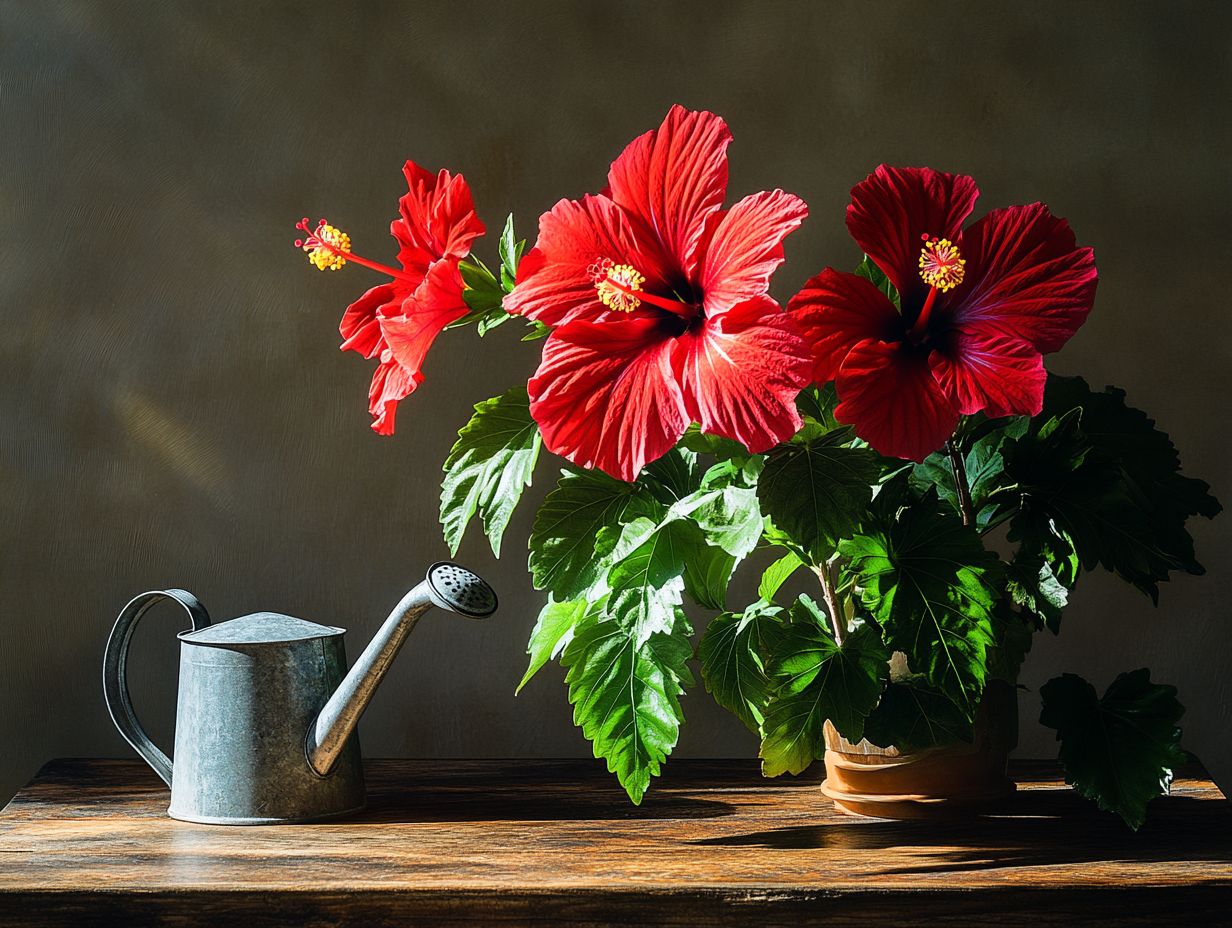
Indoor hibiscus should be watered when the top inch of soil is dry. This usually translates to once or twice a week, but it may vary depending on the temperature and humidity levels in your home!
Do indoor hibiscus plants need a lot of sunlight?
Yes, indoor hibiscus plants thrive in bright, indirect sunlight. They should receive at least 4-6 hours of sunlight daily. If your home doesn’t have enough natural light, consider using a grow light to supplement!
How do I fertilize my indoor hibiscus?
Use a balanced, water-soluble organic fertilizer once a month during the growing season (spring and summer). Dilute the fertilizer to half strength and avoid fertilizing during the winter months, especially for heavy feeder plants like hibiscus!
Can I prune my indoor hibiscus?
Yes, light pruning is important for maintaining the shape and health of your indoor hibiscus. Prune in early spring, before new growth begins, and remove any dead or damaged branches.
This will encourage fuller growth and help manage flower buds. Get ready to give your hibiscus a fresh start!
What are common pests and diseases that affect indoor hibiscus?
Common pests include aphids, spider mites, and mealybugs. Treat these with insecticidal soap, a safe way to kill pests, or neem oil.
Be cautious of pests that thrive on nitrogen, as they can hinder growth. Hibiscus plants are also prone to fungal diseases, so ensure good air circulation and avoid over-watering.

